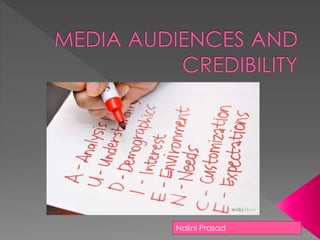
MEDIA AUDIENCES AND CREDIBILITY
- 2. “Audience doesn’t constitute itself, it doesn’t know itself, it doesn’t govern itself. All is done by institutional bodies- media organization, research and government agencies. Thus, audience is the ‘imagined community that enables those institutions to operate. -ANDERSON (1991)
- 3. Without audiences there would be no media. Media organizations produce media texts to make profit – no audience = no profit. The mass media is becoming more competitive than ever to attract more and more audiences in different ways and stay profitable.
- 4. An individual or collective group of people who read or consume any media text.
- 7. Passive audience theory (the hegemonic model) The idea that the media ‘injects’ ideas and views directly into the brains of the audience, therefore controlling the way people think and behave. Media has a direct and powerful effect on it’s audience. Can you think of any examples of this in the media today or in history?
- 8. Active audience theory argues that media audiences do not just receive information passively but are actively involved, often unconsciously, in making sense of the message within their personal and social contexts. Decoding of a media message may therefore be influenced by such things as family background, beliefs, values, culture, interests, education and experiences.
- 10. Digital technology has also led to an increasing uncertainty over how we define an audience, with the general agreement that a large group of people reading the same thing at the same time is out-dated and that audiences are now ‘fragmented’. The division of audiences into smaller groups due to the variety of media outlets.
- 11. Mass audience •Mass audience – often termed ‘broadcast audience’. Those who consume mainstream or popular texts such as soaps or sitcoms. Media and communication that targets a very large group of people (women, men, children, adults etc.) Niche audience •much smaller but very influential. A niche audience is a small, select group of people with a very unique interest.
- 12. McQuail, Blumler and Brown (1972) mentioned 4 major areas of need which the media in general seek to gratify. Diversion: an escape from routine and problems, an emotional release. Personal relationships: companionship, feeling part of a social group. Personal identity: exploring or reinforcing our own values through comparison through others values (this would include the values of the media producers and of celebrities). Surveillance: the need for a constant supply of information about what is happening in the world.
- 13. Emphasises what the audiences for media products do with them. Power lies with the individual consumer of media who is imagined as using particular programmes, films or magazines to gratify certain needs and interests. The audience is made up of individuals free to reject, use or play with media meanings as they choose • THE AUDIENCE IS ACTIVE.
- 14. Stuart Hall claimed that audience members share certain frameworks of interpretation and that they work at DECODING media texts rather than being ‘affected’ in a passive way. So Media producer ENCODES meanings into text Media consumer (the audience) DECODES meanings (relies on our own experiences, social demographic etc.)
- 16. DOMINANT- where the reader recognises what the programmes ‘preferred’ or offered meaning is and broadly agrees with it…eg flag waving patriot who responds enthusiastically to Presidents speech. OPPOSITIONAL- where the dominant meaning is recognised but rejected for cultural, political, or ideological reasons…eg pacifist who understands the speech but rejects it.) NEGOTIATED- where the reader accepts, rejects or refines elements of the programme in the light of previously held views.
- 17. CREDIBILITY means trustworthiness and competence. Before the audience accepts any message he will judge whether the communicator and the organization the individual represents, can be relied upon and is competent enough to give the information. Aristotle divided the aspects of persuasion into three categories: ethos (credibility), pathos (emotion) and logos (logic).
- 18. Media credibility refers to the perceived believability of media content "beyond any proof of its contentions.“ Media credibility research has shifted the focus from characteristics of individual, personal sources to characteristics of media behaviour such as objectivity, accuracy, fairness, and lack of bias.
- 19. Message The recommendations from research, the technology constitute the content or subject matter, the message. Information which is relevant to particular set of audiences, constitute the messages, otherwise for them this is ‘noise’. A good message clearly states what to do, how to do, when to do and what would be the result. Messages which are relevant, interesting, useful, profitable, credible (latest and best, based on research findings) and complete (neither too much, nor too little) are likely to motivate the people.
- 20. Media occupies a significant part of people’s daily lives, it significantly impacts the social construction of reality, the shape of public consciousness and the direction of socio-political change. Therefore, media's credibility is as important as the message itself. Television viewers find hard news more credible than soft news. The credibility assigned to different media varies by race and gender of news consumers. Communication to be successful must be target oriented. Response of the audience is the ultimate objective of any communication function.
